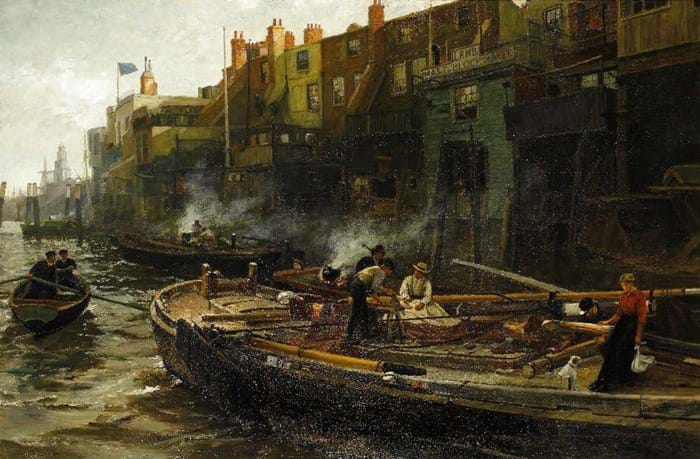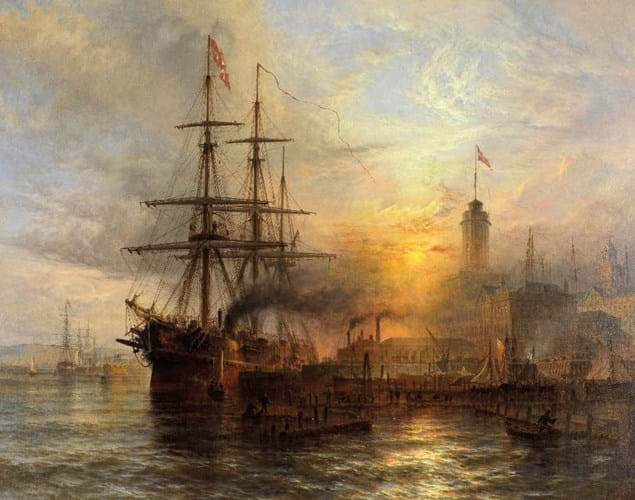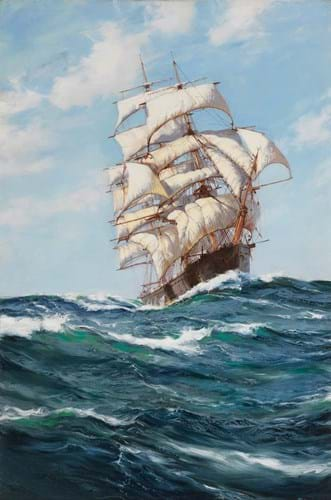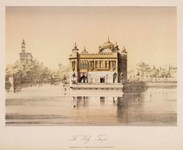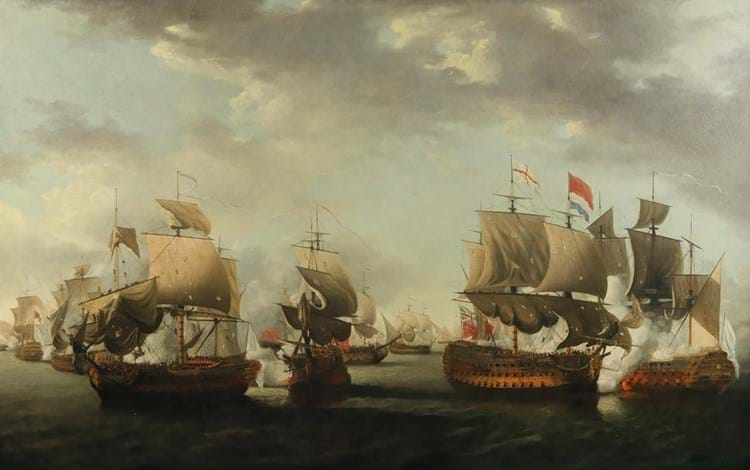
Known to history as the Battle of the Saintes, Lord Rodney’s decisive victory over the French fleet off Guadeloupe in April 1782 is generally regarded as saving the valuable island of Jamaica from invasion.
While the subject featured relatively widely in marine painting at the time and indeed afterwards, this particular work was an interesting collaboration between the naval artist Nicholas Pocock (1740-1821) and James Martin Hilhouse, one of Bristol’s eminent shipbuilders. It was signed J Hilhouse to the lower left.
Hilhouse was a skilled naval draughtsman and 16 of his drawings are in the collection of the Bristol Museum & Art Gallery. While not known as a painter (no examples of oil paintings are known), it seems likely that he produced some outline conceptions for this work and then commissioned the more proficient Bristol-born artist Pocock to paint the version on canvas.
The picture at the auction in Knightsbridge, London, on April 26 was one of a pair – the other work depicts the final stage of the Battle of the Saintes and is also now in the Bristol Museum & Art Gallery.
This 3ft 6in x 5ft 7in (1.07 x 1.69m) oil on canvas depicted a key moment earlier in the battle when Rodney’s 98-gun flagship HMS Formidable broke the French line. Rodney threw the French ships into utter confusion by piercing their line of battle in two places and then surrounded their flagship, the 104-gun Ville de Paris.
According to Francis Greenacre in his book Marine Artists of Bristol, the two works should be regarded as much more in the hand of Pocock rather than Hilhouse.
“Both paintings are not only very close in style to Pocock,” he wrote, “they are also far too proficient in technique for an artist of no known experience in the medium [Hilhouse].”
The picture at Bonhams came to auction from a private UK vendor who had purchased it at Sotheby’s in 1996. It was in relatively good condition for a painting of its age although it had undergone some restoration many years ago.
Estimated at £25,000-35,000, it drew decent interest and came down to a battle between a private client in the room and a northern dealer on the phone who eventually bought it for stock at £65,000, a sum towards the upper echelons of Pocock prices.
The result was above another view of Battle of the Saintes by Pocock that took $47,500 (£28,075) at Sotheby’s New York back in 1998, but behind the £120,000 for his painting of HMS Formidable at the same battle that fetched £120,000 at Christie’s in 2012, a price that still holds the auction record for the artist.
Busy Thames
Also bringing demand at the Bonhams sale was a painting of the London docklands by Charles Napier Hemy (1841-1917).
The large and atmospheric picture was a late work (it was exhibited at the Royal Academy in 1914) and had previously been in the famous collection of the soap industrialist William Hesketh Lever, 1st Viscount Leverhulme.
After his death, it was sold at auction and acquired for the Bolton Museum and Art Gallery. However, it was later deaccessioned and sold at Bonhams in 2012 for £24,000, going to the private UK buyer who was the vendor here.
The Riverside, Limehouse, a 4 x 6ft (1.23 x 1.83m) signed oil on canvas was part of series of works by Hemy depicting the busy mouth of the Thames with the old buildings on the banks – an area also painted by his friends Whistler and Tissot. Whistler etchings known as ‘The Thames Set’ are believed to have had a great influence on Hemy.
The setting seems to have had particular significance for Hemy. At the age of 10 he set sail for Australia with his family from a nearby stretch of the Thames which he later recalled: “I can remember it (the open sea) entered my soul, it was imprinted on my mind, and I never forgot it.” This may explain what appears to be a touch of moody nostalgia in the current work.
Estimated at £20,000-30,000, it drew good interest and sold at £55,000 to a private UK client bidding online – the fourth-highest price for Hemy at auction according to Artprice and a good return for the vendor who had bought it at Bonhams in 2012, even accounting for inflation.
Dawson family pedigree
Another moody picture making a notable return was a painting by Henry Thomas Dawson (c.1841-96) of a Danish steamer moored at the docks in Portsmouth.
The Hull-born marine specialist lived in Liverpool and then moved to London in the late 1840s. He was the father of the painter and etcher Alfred Dawson and the grandfather of Montague Dawson.
The 2ft 10in x 3ft 7in (85cm x 1.08m) oil on canvas was clearly a major work. Signed and dated HTD Jun. 1874, it had all the elements buyers look for in this market: a dramatic sunset, whirling sky, calm waters and a detailed depiction of the ships, docks and rigging.
The work sold at auction not too long ago, making £10,000 at Christie’s in 2020, and had since been with dealer Haynes Fine Art from where a private UK collector had acquired it (here it was part of their deceased estate).
The previous auction price may have informed the £8000-12,000 estimate here but this time it drew a mix of UK and US bidders and sold at £20,000, a record for the artist at auction. The buyer was a private UK client bidding online.
Meanwhile, a work by his grandson Montague Dawson (1895-1973) at Bonhams depicting the full-rigged American merchantman Forest Queen took £30,000. The ship was built in 1858.
Not being entirely fresh to the market, the 3 x 2ft (92 x 62cm) oil on canvas had been unsold at Sotheby’s New York in 2013 against a $40,000-60,000 estimate but had then managed to get away at $24,000 (£14,530) at the same saleroom the following year. The vendor had then purchased the work from an auction in Nevada in 2021 where it sold for $37,500 (£26,980).
Here, estimated at £30,000-50,000, it was knocked down at the lower end of expectations to a UK private buyer on the phone.


